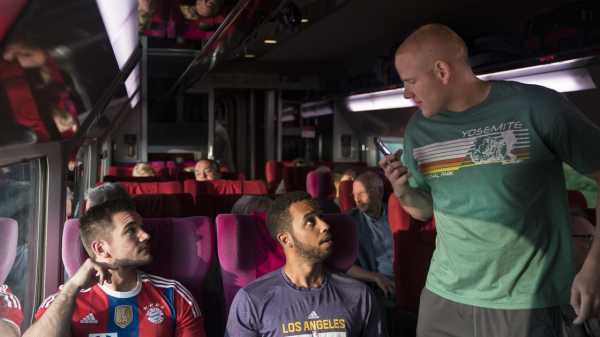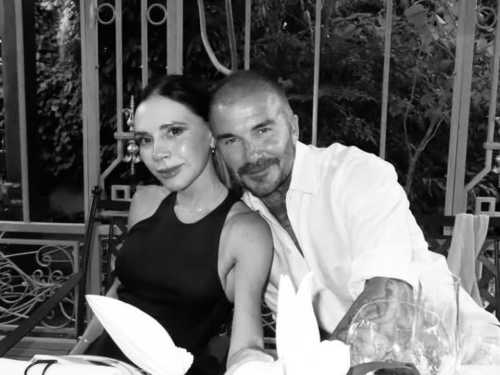
The new Clint Eastwood movie, “The 15:17 to Paris,” may be the weirdest
film of the year. It’s a thrusting reactionary fable that ends up
bumping into the rear of the avant-garde. If the outlaw Josey Wales had
put on white makeup and retrained as a mime artist, I couldn’t have been
more surprised.
The plot is simple and, for the most part, true. On August 21, 2015, a
Moroccan named Ayoub El Khazzani boarded a train to Paris, which had
begun its journey in Amsterdam. In the toilet, he removed his shirt and
armed himself with an assault rifle, a pistol, and a box cutter.
Carrying almost three hundred rounds of ammunition, he emerged and made
his way into the adjacent car. The rifle was wrested from him by an
American-born Frenchman, Mark Moogalian, only for El Khazzani to shoot
him with the pistol. The assailant retrieved the rifle, levelled it at a
young American airman, Spencer Stone, and fired. The gun jammed. Stone
and two of his friends, Alek Skarlatos and Anthony Sadler, felled El
Khazzani and held him down. He was beaten in the face with the rifle
butt, subdued, and tied up. Stone, badly cut in the struggle, then
attended to Moogalian, who was bleeding profusely from a neck wound. The
train soon stopped at Arras and the French police arrived. Khazzani was
arrested and taken away. Paramedics took over from Stone. Nobody died.
It was quite a story at the time, and the news coverage was excitable
and widespread. But how do you make a ninety-four-minute movie out of an
incident that lasted a matter of minutes, however crazed those minutes
may have been? Eastwood’s solution, with the aid of his screenwriter
Dorothy Blyskal, is to flick back through the histories of his heroes.
Just as the attack on the train is about to erupt, we cut to Sacramento,
in 2005, where Spencer and Alek are buddies, and where their mothers are
called in by the principal, who diagnoses attention-deficit disorder and
advises medication. “You want to drug my child to make your job easier?”
one of the moms asks. An excellent retort, for anyone wishing to hold
back the tide of Ritalin, but even here you can feel the movie glancing
to the future: might there not come a time, and a place, in which to be
restless and alert will prove to be an advantage?
The boys are moved to a Christian middle school, where, once again, they
are constantly in trouble, and where they meet the young Anthony on the
basketball court. “I had no idea you guys were so cool,” he says. Me
neither. In one peculiar sequence, he goes round to see Spencer, who
opens his closet and hauls out an entire arsenal of toy guns, tossing
them onto the bed. “You never been hunting?” he says, adding, “Let’s go
and find Alek and play war.”
As I watched the scene, I thought, You could cut it out of this movie
and paste it, unchanged, into another one, about a nice suburban kid who
grows up and carries out a mass shooting. Eastwood, however, plays
things straight, without a shimmer of unease, preferring to frame
Spencer’s obsessive hoarding of weapons as a healthy pastime and also,
naturally, as a preparation for the hour—or the seconds—of crisis that
will define his adult life. The toys will save lives. To be fair, such
an argument will make perfect sense not just to members of the N.R.A.
but to countless families in Middle America, especially those who are
sending their sons and daughters into the military. But you can’t help
recalling Eastwood’s “American Sniper” (2014), which is no less
respectful towards true-life valor than “The 15:17 to Paris,” yet far
more tensed and unhappy, and touched with deep anxiety about the zone
where children and violence meet. Think of the sniper’s expression when
a kid, squarely in his sights, prepares to fire a rocket-propelled
grenade. Think of the Iraqi boy and his mother, also armed with a
grenade, whom the sniper shoots when they approach a U.S. tank. Think of
the creepy scene in which, back in Texas with his wife and children, he
pretends to be a cowboy, prowling his own home with pistol drawn.
Some viewers hailed that film as a waving of the flag. Others saw the
price that was paid by the soldiers and their kinfolk, in body and mind,
for the sake of a questionable cause, as uncomfortably high. No such
discord hovers around Eastwood’s new movie. It’s a hundred per cent
endorsement of a cultural rescue: natural-born warriors, made in
America, take down the Muslim fanatic and, not for the first time, save
those lazy-ass Europeans from a fate they can’t themselves defeat. To an
extent, that is accurate; scores of people could have died on the train
were it not for Stone and his pals, and everything in the movie arrows
towards that point. In flashback, we follow Skarlatos as he serves in
the Army National Guard, with the rank of specialist, in Afghanistan,
and Stone as he works himself into shape and joins the Air Force (though
not the branch of it he was really hoping for, being disqualified for
lack of “depth perception” after an eye test). The two of them team up
with Sadler for a vacation in Europe, and, one day, gazing out over
Venice and the lagoon, Stone asks him, “I don’t know, man, d’you ever
just feel like life is just catapulting you towards something, some
greater purpose?”
What makes the movie peculiar is not the plot, or the back-and-forth
structure, or the staging of the climactic fight, which is done with the
clarity and the economy that we have come to expect, over the decades,
from the director. (He is now eighty-seven.) The oddity is the cast.
There are professional actors in the film, but mostly in lesser roles:
Jenna Fischer as Skarlatos’s mother, for example, and Judy Greer as
Stone’s. But all the major protagonists, as grownups, play
themselves—Stone plays Stone, Sadler plays Sadler, and so on. Most
disturbing of all is that Moogalian plays Moogalian. In other words, he
has to run down the corridor of a train, pretend to get shot, pretend to
collapse, and lie there with fake blood pouring out of a fake hole in
his neck, which is being plugged by the fingers of a real compatriot.
Looking on is his real wife, Isabelle, who also plays herself; rushing
to his aid, before too long, is the same paramedic who originally
hurried aboard at Arras and gave him morphine for the pain. But there is
no pain, this time. Oh, well, I guess that’s one way to recover from an
overwhelming trauma: reconstruct it, down to the last drop.
Though unusual, this kind of thing is not unprecedented. One of the most
celebrated American combatants of the Second World War, Audie Murphy,
was persuaded to star as himself in “To Hell and Back” (1955), which
told his own remarkable story and became a huge success. Some of that
movie is echoed by “The 15:17 to Paris.” We visit Murphy’s early years,
in Texas, with the young Audie played by a child actor. Also, just as
Eastwood rounds off his movie by showing actual footage of President
François Hollande presenting Stone and the others with the Légion
d’Honneur, in the Élysée Palace, so “To Hell and Back” ends with
Murphy’s being awarded the Medal of Honor, which can barely fit
alongside the host of other decorations that adorn his uniform. (He was
kind of a shrimp, a source of amusement to his men.) Like Stone,
Skarlatos, and Sadler, Murphy is no great actor, but, like them, he’s
affable enough, and he sees the movie through.
He has one advantage over his modern counterparts, in that many of his
lines of spoken dialogue are either on the battlefield or under
conditions of service, between ranks—useful cover for any stiffness of
delivery. By contrast, you have to feel sorry for Stone and the others
as they shoot the breeze on Skype, or mosey around Europe doing the
obvious stuff (“I just want my selfie of the Eiffel Tower and we’re
good,” Sadler says), or wake up foggy and hungover in Holland after too
much booze and a pole-dance. I hope the drinks were real, at least. That
kind of informality is much harder to carry off, for unpracticed
performers, than it appears, and you can sense the guys’ relief when, at
last, after Eastwood has teased us with glimpse after glimpse of the
audacious climax, they get to prove themselves afresh in the action at
which—as the world discovered—they excel. It’s a still far cry from
Audie Murphy, though, who fought in Sicily, Anzio, southern France, and
Alsace, where he stood on an abandoned tank destroyer, which was on
fire, and single-handedly repelled the Germans’ advance. Asked why he
had done so, he replied, “They were killing my friends.”
One guy coming out of a toilet, however monstrous his intentions, is no
match for that. “The 15:17 to Paris” suffers from an excess of dramatic
wadding, and the over-all effect is too muffled and often too dull,
sadly, to make an impact. The movie, like Stone’s vision, is short on
depth perception. Yet it’s trailed by a ghost, I would suggest, of the
film it could have been. Imagine if professional actors had assumed
command. Imagine if everybody involved in the desperate tussle had
received the biographical treatment, in much more concentrated form,
that Eastwood bestows on Stone, Skarlatos, and Sadler. How about Chris
Norman, the British businessman who was given the Légion d’Honneur
alongside the Americans? What was his story that day? Or the French
banker who was the first person to tackle the gunman? (He elected not to
appear in the film, and his name has not been released. We are told that
two French citizens were decorated for their bravery on the train, but
that important information is shyly tucked away in the end credits.)
Above all, what of Ayoub El Khazzani, the Moroccan at the heart of these
events, who was already on the radar of the authorities in both Spain
and France? Was this not an ideal opportunity to trace the paths—whether
of grievance, paranoia, faith, or wrath—that lead a young man to dreams
of slaughter? Was he not, in his way, catapulted towards his purpose no
less firmly than Stone and his companions were, and with an equally
fervent belief that he was obeying the decrees of his God? For answers
to such inquiries, of course, you would have to ask El Khazzani himself,
but he was not at liberty, for understandable reasons, to re-create his
role for this perplexing movie. Not even Clint Eastwood could arrange
that.
Sourse: newyorker.com






